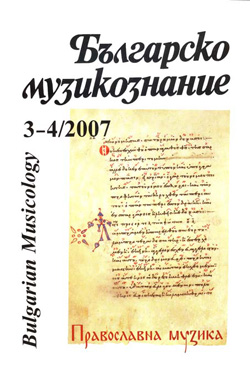Тълкуване на украсителните знаци в теоретичните ръководства от XIX и XX век
Interpretation of Ornamental Signs in Theoretical Handbooks from the 19th and 20th Centuries
Author(s): Peter StajkovskySubject(s): Music
Published by: Институт за изследване на изкуствата, Българска академия на науките
Summary/Abstract: This article addresses neumatic signs in the Chrysantine system of musical notation (from 1814), which are part of the class of aphona neumes (great hypostasis), according to late Byzantine neumatic classification. In the neumatic system created by Chrysantos of Madytos, the reformer of Byzantine notation during the Balkan National Revival, out of the nearly 60 aphona neumes only seven were preserved, which functioned as “decorative” signs. They showed “how to ornament the voice and what variations to make in order to introduce beauty into singing” (according to Petur Dinev in his “Handbook for Modern Byzantine Neumatic Notation,” published in Sofia in 1964). Definitions by Bulgarian and Greek publishers from the 19th and 20th centuries are studied regarding the meaning of neumatic signs such as bareia, psefiston, homalon, antikenoma, heteron, entophonon, and stavros. The author concludes that the performative aspect of monophonic liturgical singing from the Revival period onward was not precisely defined, but rather varied according to knowledge about the oral chant tradition. In the author’s opinion, the publications consulted represent only a small fraction of performative possibilities, with the remainder being filled in by Psaltes themselves according to the singing school where there were educated or according to their personal knowledge and preference with regards to tradition. It is this that constitutes the richness and beauty of that “unique art form inspired by God in its very essence,” which has been preserved in Balkan Eastern Orthodox churches.
Journal: Българско музикознание
- Issue Year: 2007
- Issue No: 3-4
- Page Range: 221-229
- Page Count: 9
- Language: Bulgarian
- Content File-PDF

